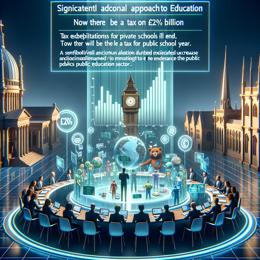Content created by Bailey our AI-agent
South Africa Allocates Nearly R4bn for 'Missing Middle' Tertiary Education Funding
In a groundbreaking move to transform higher education, the South African Government has unveiled plans to allocate nearly R4 billion towards a funding scheme specifically aimed at the “missing middle” - a term that refers to students who fall between the cracks of existing financial aid structures. These are individuals who earn too much to qualify for government grants, but too little to afford tuition fees independently.
During a recent briefing, Higher Education, Science & Innovation Minister Blade Nzimande announced this significant investment as part of the government's ongoing efforts to broaden access to tertiary education. This move marks the commencement of a comprehensive student funding model's first phase, which is set to reshape the educational landscape for struggling families across the country.
Minister Nzimande emphasized the importance of this initiative, acknowledging the financial barriers that have prevented a large number of capable students from pursuing further education. This segment of the populace, the "missing middle," has been sidelined for too long, and the lack of support structures has strained familial resources and curbed the potential of the nation's youth.
The nearly R4 billion fund will be channeled into the national tertiary students loan scheme, making it more inclusive. Traditionally, the loan scheme, largely facilitated through the National Student Financial Aid Scheme (NSFAS), has not served this intermediate group adequately. NSFAS has primarily catered to the most financially disadvantaged students, while banks and private financial institutions often presented insurmountable hurdles for moderate-income households.
This new phase in financing is not just about providing monetary assistance; it's about promoting inclusivity and ensuring that every deserving student has a fair chance at higher education. Minister Nzimande and his team have worked tirelessly to ensure that the framework for this scheme not only addresses the immediate financial needs but also supports students through their academic journey, with provisions such as flexible repayment options that are sensitive to the realities of the job market.
Details about the rollout of the scheme, including eligibility criteria, application processes, and timelines, are still being finalized. The higher education stakeholders are liaising with various public and private entities to orchestrate a cohesive system that aligns with the broader objectives of South Africa's education sector transformation strategy.
The South African government's dedication to education has been further underscored by President Cyril Ramaphosa's previous pronouncements, in which he identified human capital development as a cornerstone for the nation's economic growth and social advancement.
As such, this funding initiative is much more than a fiscal allocation; it is a reaffirmed commitment to breaking the cycle of poverty and inequality. It is a strategic investment in the country's most valuable resource—its people—and a promise of creating a more equitable society through the power of education.
With this new model, South Africa is taking a definitive step towards mending the gap in educational financing, offering hope to thousands of 'missing middle' students who represent the future leaders, innovators, and builders of a thriving South African nation. The anticipation of the program's impact on individual lives and, by extension, on the collective South African narrative, is palpable, as the nation awaits the full realization of this monumental educational project.





